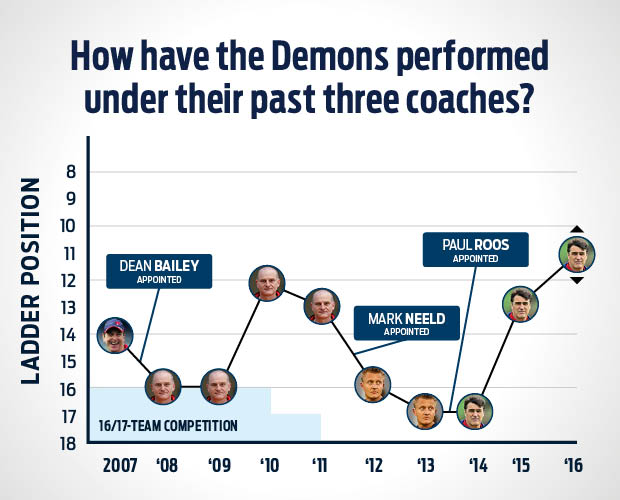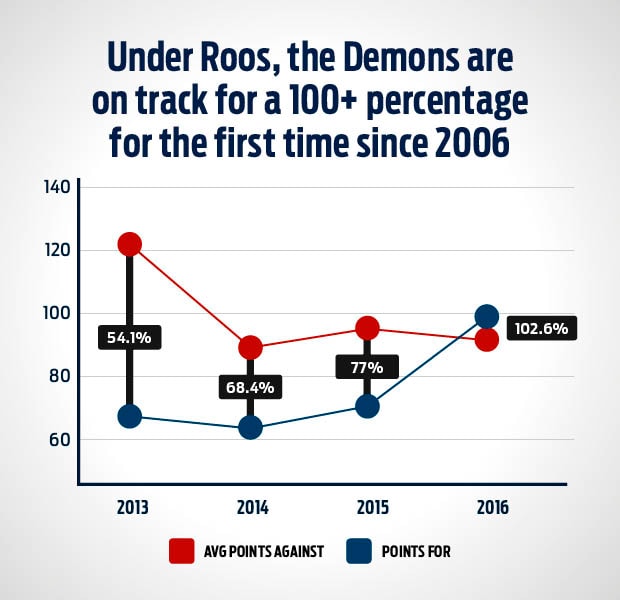SATURDAY'S hoodoo-snapping victory over Hawthorn is likely to be remembered as Paul Roos' finest moment at Melbourne.
But even before that stunning upset, he could have handed over the keys to coach-in-waiting Simon Goodwin deeply satisfied with his three-year salvage mission.
When Roos was coaxed out of coaching retirement in September 2013, the Demons had hit rock-bottom.
Melbourne was coming off a woeful season of just two wins with a paltry percentage of only 54.1 – and priority number one was obvious.
"We need to get competitive, (54) is an unacceptable percentage," Roos said at the time of his appointment.
On that front, along with many others, the outgoing mentor gets a big tick.
Melbourne should finish the year topping 100 per cent (they stand at 102.6) for the first time since 2006 – the last time the club played finals.
Each season under Roos they've climbed the ladder, first limiting the thrashings that cost Mark Neeld his job and then shedding the easy-beats tag.

Roos steadied the ship, preached patience, sold hope, turned over the playing list and support staff, and taught basics-first to the club's emerging stars.
Starting at ground zero, he stripped back the game-plan and put the emphasis on contested football to relieve an under-siege backline.
Borrowing from his premiership-winning tenure at the Sydney Swans, ball-ups and boundary throw-ins increased (+8 stoppages per game), contested possession differential improved (18th to 12th) and the Dees made life tougher for opponents to score.
They conceded a whopping 33 points fewer per match (122.3 to 88.8), won four games and their percentage bounced up to 68.4.

Solid foundations were set in stone. Next, attack had to be built on top.
"We were a team that could defend, but we were exhausted when we got the ball and we'd struggle to get it forward," Roos told AFL.com.au leading into the 2015 campaign.
"That's what the best teams in the AFL do – the two-way running teams. That's what AFL footy demands."
In 2015, long-suffering fans started to see the first glimpses of the hard-running offence that overwhelmed the Hawks.
The young Dees released the shackles, playing on more from marks (up four per cent) and speeding up their ball movement (16th to seventh) from defence to attacking 50.
Scoring subsequently jumped by two goals a game as NAB AFL Rising Star winner Jesse Hogan announced himself and the Dees won seven matches – including a watershed triumph over the Cats in Geelong.
This year was all about balance.
The Demons have tightened up defensively once again, and their attack is becoming deadly.
Melbourne (average 92 points for) is closing in on the magical 100-point barrier needed to become a flag contender, while the Dees also move the ball at breakneck speed (second-fastest average movement from D50 to F50) and play on from marks more than any other side.
What a finish from the Dees! #AFLDeesHawks https://t.co/dh5traYBXx
— AFL (@AFL) August 6, 2016
But, crucially, the fundamentals of contested ball – the Demons are ranked fifth in the AFL – haven't been forgotten.
Although Roos' men will probably miss out on the top eight, the fact they're in the conversation still entering round 21 is an achievement in itself.
They've already won their most games (nine) in a decade, boast the League's dominant ruckman Max Gawn and are assembling a tough and talented midfield brigade around him – partly by bringing in six top-10 drafted players over the past three years.
Stalwarts Nathan Jones and Jack Watts can see the light at the end of the tunnel – this time it's not an oncoming train – and Roos hopes the squad he helped build can kick on to achieve sustained success.
"It will be one of the highlights of my football career if they can get to September and go deep into September, and me sitting in the grandstand watching," Roos told 3AW on Sunday.
"I'd be the first one to congratulate Simon and the players, because it is pretty exciting for the club."
STATS QUIRK OF THE WEEK: Geelong skipper Joel Selwood led the club's tackle count against Essendon on Sunday with four tackles. It was the first time since round eight, 2010 that the Cats' leading tackler laid so few tackles in a match.
• Read more from the Stats Files




